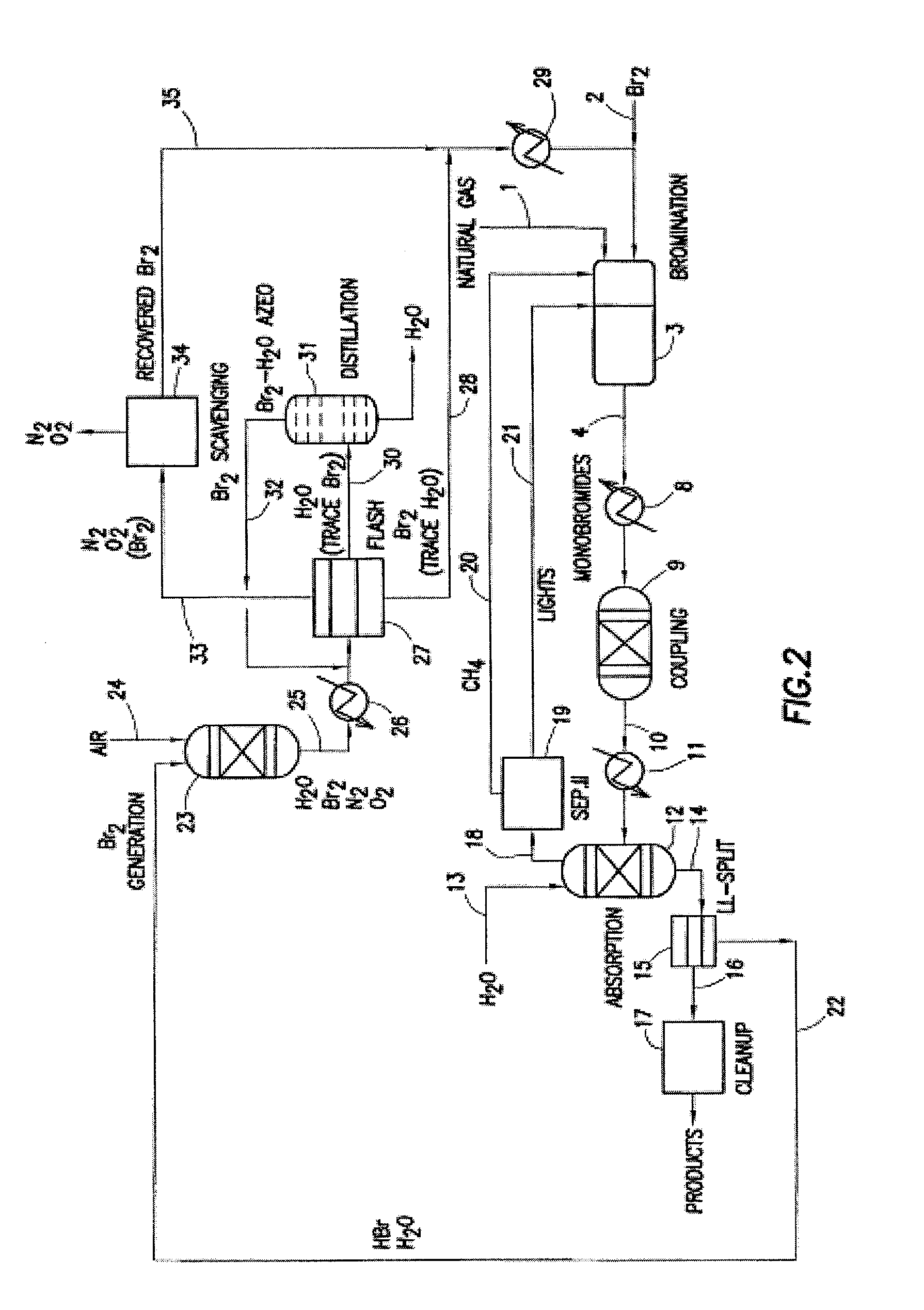Continuous Process for Converting Natural Gas to Liquid Hydrocarbons
a liquid hydrocarbon and natural gas technology, applied in the field of carboncarbon coupling, can solve the problems of oxidative halogenation, production of perhalogenated products and an unacceptable quantity of deep oxidation products, and production of dibromomethane and other polybrominated alkanes
- Summary
- Abstract
- Description
- Claims
- Application Information
AI Technical Summary
Benefits of technology
Problems solved by technology
Method used
Image
Examples
example 1
Reproportionation of Dibromomethane with Propane
[0252]Methane (11 sccm, 1 atm) was combined with nitrogen (15 sccm, 1 atm) at room temperature via a mixing tee and passed through a room temperature bubbler full of bromine. The CH4 / N2 / Br2 mixture was plumbed into a preheated glass tube at 500° C., and bromination of the methane took place with a residence time (“tres”) of 60 seconds, producing primarily bromomethane, dibromomethane, and HBr. The stream of nitrogen, HBr, and partially brominated hydrocarbon was combined with propane (0.75 sccm, 1 atm) in a mixing tee and passed into a second glass reactor tube at 525° C. with a residence time (“tres”) of 60 s. In the second reactor tube, polybrominated hydrocarbons (e.g., CH2Br2, CHBr3) react with the propane to produce bromopropanes. The reproportionation is idealized by the following reaction:
CH2Br2+C3H8→CH3Br+C3H7Br
[0253]As products left the second reactor, they were collected by a series of traps containing 4 M NaOH (which neutral...
example 2
Separation of Anhydrous HBr
[0254]20 ml stock HBr aqueous solution were added to 20 g CaBr2H2O followed by heating to 70° C. A significant evolution of HBr gas was observed (determined by AgNO3 precipitation and the NH3 fuming test). The released HBr was not quantified as the reaction was carried out in an open vessel.
example 3
Separation of Anhydrous HBr
[0255]Dehydration with H2SO4 was attempted by adding a concentrated solution of H2SO4 to HBr. Qualitative tests were conducted in which different concentration of H2SO4 were added to HBr for determination of the threshold concentration where oxidation of HBr no longer occurs: 2HBr+H2SO4→Br2+SO2+2H2O
[0256]It was determined that the H2SO4 concentration below which no oxidation is apparent is about 70 wt. %. 30 ml 70% H2SO4 was added to 30 ml stock HBr azeotrope (48 wt. %) and the mixture was heated to boiling. The HBr content was determined quantitatively by AgNO3 precipitation and gravimetric determination of AgBr from a solution aliquot at the moment of mixing, after 15 min and after 30 min boiling.
PUM
| Property | Measurement | Unit |
|---|---|---|
| Temperature | aaaaa | aaaaa |
| Temperature | aaaaa | aaaaa |
| Pressure | aaaaa | aaaaa |
Abstract
Description
Claims
Application Information
 Login to View More
Login to View More - R&D
- Intellectual Property
- Life Sciences
- Materials
- Tech Scout
- Unparalleled Data Quality
- Higher Quality Content
- 60% Fewer Hallucinations
Browse by: Latest US Patents, China's latest patents, Technical Efficacy Thesaurus, Application Domain, Technology Topic, Popular Technical Reports.
© 2025 PatSnap. All rights reserved.Legal|Privacy policy|Modern Slavery Act Transparency Statement|Sitemap|About US| Contact US: help@patsnap.com



